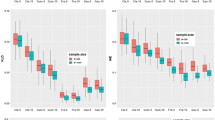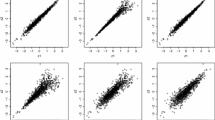Abstract
In the analysis of medical data the whole lifetime is often split into pieces characterizing the various stages in the development of a chronical disease. In this paper we provide a nonparametric copula function estimator for two consecutive survival data which are subject to truncation and right censorship. We also discuss an extension of Spearman’s Rho and Kendall’s Tau to the present situation.
Similar content being viewed by others
References
Bahadur RR (1966) A note on quantiles in large samples. Ann Math Stat 37:577–580
Brookmeyer R, Gail MH (1994) AIDS epidemiology. A quantitative approach. Oxford University Press, New York
de la Peña VH, Giné E (1999) Decoupling: from dependence to independence. Springer, New York
Deheuvels P (1979) Propriétés d’existence et propriétés topologiques des fonctions de dépendance avec applications à la convergence des types pour les lois multivariées. C R Acad Sci Paris, Ser A 288:145–148
Deheuvels P (1981) A Kolmogorov–Smirnov type test for independence and multivariate samples. Rev Roum Math Pures Appl Tome XXVI:213–226
Fermanian JD, Radulovic D, Wegkamp M (2004) Weak convergence of empirical copula processes. Bernoulli 10:847–860
Gaenssler P (1983) Empirical processes. IMS lecture notes—monograph series, vol 3
Gaenssler P, Stute W (1987) Seminar on empirical processes. DMV seminar, vol 9. Birkhäuser, Basel
Genest C, Favre A-C (2007) Everything you always wanted to know about copula modeling but were afraid to ask. J Hydrol Eng 12:347–368
Genest C, Rémillard B (2004) Tests of independence and randomness based on the empirical copula process. Test 13:335–369
Genest C, Rémillard B, Beaudoin D (2009) Goodness-of-fit tests for copulas: a review and a power study. Insur Math Econ 44:199–213
Kruskal WH (1958) Ordinal measures of association. J Am Stat Assoc 53:814–861
Li DX (2000) On default correlation: a copula function approach. J Fixed Income 9:43–45
Lynden-Bell D (1971) A method of allowing for known observational selection in small samples applied to 3CR quasars. Mon Not R Astron Soc Lett 155:95–118
Nelsen RB (2006) An introduction to copulas. Springer, New York
Omelka M, Gijbels I, Veraverbeke N (2009) Improved kernel estimation of copulas: weak convergence and goodness-of-fit testing. Ann Math Stat 37:3023–3058
Ruymgaart FH (1978) Asymptotic theory of rank tests for independence. Math. centre tracts, vol 43. Amsterdam
Schweizer B, Wolff EF (1981) On nonparametric measures of dependence for random variables. Ann Stat 9:879–885
Segers J (2012) Asymptotics of empirical copula processes under non-restrictive smoothness assumptions. Bernoulli 18:764–782
Sklar A (1959) Fonctions de répartition à n dimensions et leurs marges. Publ Inst Stat Univ Paris 8:229–231
Strzalkowska-Kominiak E (2008) The statistical analysis of truncated and censored data under serial dependence. Dissertation, University of Giessen, Germany
Strzalkowska-Kominiak E, Stute W (2010a) The statistical analysis of consecutive survival data under serial dependence. J Nonparametr Stat 22:585–597
Strzalkowska-Kominiak E, Stute W (2010b) On the probability of holes in truncated samples. J Stat Plan Inference 140:1519–1528
Strzalkowska-Kominiak E, Stute W (2012) Nonparametric regression for consecutive survival data. South African J Stat 46:357–376
Stute W (1982) The oscillation behavior of empirical processes. Ann Probab 10:86–107
Stute W (1984) The oscillation behavior of empirical processes: the multivariate case. Ann Probab 12:361–379
van der Vaart AW, Wellner JA (1996) Weak convergence and empirical processes. Springer, New York
Acknowledgements
Ewa Strzalkowska-Kominiak acknowledges financial support from a Juan de la Cierva scholarship and Grants MTM2008-00166 and MTM2011-22392 from the Spanish Ministerio de Economía y Competitividad.
Author information
Authors and Affiliations
Corresponding author
Appendix
Appendix
The following result will be needed in the proof of Theorem 2 and applied to the marginals F 1n and F 2n of F n . It has been formulated for general distribution function estimators and their quantiles. For the special case of a classical univariate empirical d.f., Lemma A allows for remarkable extensions since then the oscillation behavior of empirical processes yields exact almost sure bounds for the remainder terms leading to the famous Bahadur (1966) representation of empirical quantiles for i.i.d. data. See also Stute (1982). Together with oscillation results for multivariate empirical processes, see Stute (1984), Gaenssler and Stute (1987) discussed bounds for the remainders of the empirical copula process. For the estimators discussed in this paper only tightness but no sharp oscillation bounds are available so far. Therefore, for the sake of completeness, we included Lemma A in a form which summarizes the conditions needed for distributional convergence and an in-probability representation without bounds.
Lemma A
Let \(\tilde{F}_{n}\) be univariate nondecreasing estimators of a distribution function \(\tilde{F}\) such that the processes
are asymptotically C-tight on compact subsets of the real line. Assume furthermore that \(\tilde{F}\) is continuously differentiable at \(\tilde{F}^{-1}(u)\) with
Then we have
The last representation holds uniformly in u whenever u varies in compact subsets of (0,1).
Proof
Since \(\tilde{\alpha}_{n}\) is asymptotically C-tight, we have \(\tilde{F}_{n} \to\tilde{F}\) on compacta, in probability. Under the assumed regularity conditions at \(\tilde{F}^{-1}(u)\), we get
By the assumed tightness,
The last difference, however, equals
We also have
and
Conclude that
By the mean value theorem, the left-hand sided is asymptotically equal to
This completes the proof. □
Rights and permissions
About this article
Cite this article
Strzalkowska-Kominiak, E., Stute, W. Empirical copulas for consecutive survival data. TEST 22, 688–714 (2013). https://doi.org/10.1007/s11749-013-0339-1
Received:
Accepted:
Published:
Issue Date:
DOI: https://doi.org/10.1007/s11749-013-0339-1




